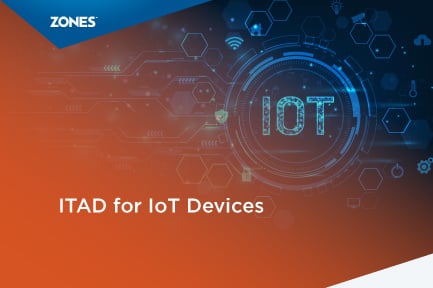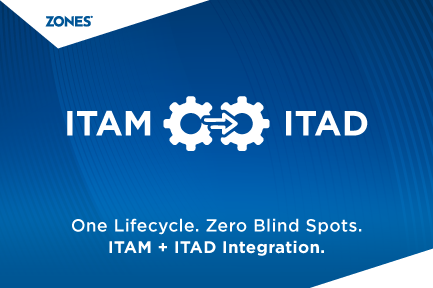IT Asset Disposition (ITAD) & Cybersecurity: Safeguarding Your Data in the Digital Age
Data security has never been as important as before, especially in the modern world, which instantly turns to the online sphere to solve most...
3 min read
![]() Zones
:
Jun 6, 2024 11:17:15 AM
Zones
:
Jun 6, 2024 11:17:15 AM

With an unprecedented rate of ongoing technological progress marked by the increasing number of mobile phones, smart gadgets, and things connected to the Internet, IT asset disposition (ITAD) has undergone a significant makeover. While companies realize the rising number and type of connected equipment, this matter remains a priority, and the evaluation of traditional ITAD methods is also required at the same time. This blog considers the problems created by the rise of mobile devices and the Internet of Things (IoT), looking at how ITAD procedures need to adjust and presenting some strategies organizations can use to cope with this ever-changing situation.
The emergence of mobile devices (smartphones and tablets) and others such as IoT (including smart home appliances and industrial sensors) has introduced another way and a new definition of technology among the population. Their portability and connectivity are just a few of the meaningful benefits of these devices. At the same time, however, they imply specific challenges related to ITAD.
Conventional ITAD procedures were developed to deal with computer workstations, laptops, and servers with an easily predictable lifecycle. Moreover, the purchase and use of mobile devices nowadays occur at a fantastic pace because of shorter upgrade cycles and different types of IoT devices, and the conventional model has been broken apart. Therefore, ITAD policies must be changed to work with the disposal and recycling of a broader range of structures, forms, and functions devices.
The diversity of mobile and IoT devices shows a complex problem. Unlike conventional IT equipment, these devices differ in form factor and operating systems, apps, and connection protocols. This diversity of devices makes handling and recycling more tricky and efficient for ITAD specialists. Each device may need individual approaches to data erasure, dismantling, and recycling, thus increasing the overall complexity of the ITAD workflow.
The diverse range of devices encompasses many, from cell phones and wearables to HVAC controls and robotic devices like Roomba1. These devices, many data-bearing, pose unique challenges for ITAD. Read the full report here.
More so, technological advancements have created a situation where products have shortened lifecycles, and hence, the products are upgraded and replaced. The division of semiconductors is ongoing, representing a bright future. Unfortunately, this poses an even more significant challenge in disposing of e-waste. Due to shorter product lifecycles, companies need to create methods to withstand premature obsolescence and a way to reduce the waste produced by keepable devices.
Data security continues to be a significant factor in the disposal of mobile and IoT devices. These devices usually store confidential information, ranging from personal data on mobile devices to vital business information in IoT sensors. The security of confidential data after disposal is mainly dependent on the implementation of proper data sanitization techniques. However, the total and unconditional wiping out of data from multiple devices is a big challenge to overcome. On the other hand, IoT's interrelatedness heightens the complexity because data may be spread over several devices and cloud services.
Data security is not only a significant concern here but also environmental sustainability while carrying out ITAD operations involving mobile and IoT devices. Generally, many such gadgets contain potentially damaging substances, including lithium-ion batteries or rare earth metals. Therefore, they can harm human health or the environment if disposed of improperly. Companies must comply with rigorous rules determining electronic waste handling, recycling, and disposal to reduce these environmental problems. Implementations of sustainable ITAD practices comprising remanufactures and reuses of devices where possible will reduce the ecological footprint of IT asset disposal.
Watch this webinar to learn more about ITAD and Data Security.
Effective inventory management tools are invaluable in maintaining the continuity of the ITAD processes. Recording all mobile, IoT, and other devices in the organization simplifies tracking their lifecycle from procurement to retirement. Automated inventory management systems enable us to identify and categorize technology and develop options for the disposal strategy.
It is pivotal in standardizing and developing proper sanitization and disposal protocols to limit the possibility of data breaches. Organizations must create guidelines for safe data encrypting processes before removing mobile devices and IoT sensors. It could lead to certified data erasure software and even physical destruction methods as security precautions. Audits and compliance controls done regularly help unveil compliance with the rules and laws in place.
Partnering with certified ITAD service providers will streamline disposal and ensure it corresponds to industry standards. These suppliers usually have the necessary skills and capital to manage various mobile and IoT devices, from secure data erasing to responsible recycling. By engaging reputable vendors for their ITAD activities without losing focus on the primary operations, companies will be confident that their surplus IT assets are correctly disposed of.
Awareness training on the significance of adhering to ITAD procedures will help the employees take precautions and lessen the chances of penalties and related liabilities. Training programs should focus on topics like data security practices, environmental stewardship, and the rules from regulatory agencies. Employees would be equipped with the necessary knowledge and skills to explore the proper disposal of IT assets, ensuring organizational security and preventing compliance violations.
To summarize, the growth in the usage of mobile and IoT devices is creating a new level of complexity for the ITAD processes. Despite that, aggressive approaches and innovative technology usage will allow business players to withstand the dynamic nature of the digital age. From complex things like inventory management to highly sophisticated data sanitization processes, handling the unique features of mobile and IoT devices is a multi-step process. Achieving data security, environmental sustainability, and legal and regulatory compliance is vital for organizations to develop effective ITAD processes addressing today's digital sphere.
With our expertise in e-waste disposal and data destruction, decades of operational excellence, partnerships with EPA-compliant recyclers, and customized solutions, Zones offers full compliance and peace of mind.
So, let us take care of your ITAD needs and experience a smooth and sustainable transition for your technology assets.
-%26-Cybersecurity-Blog-Image.png)
Data security has never been as important as before, especially in the modern world, which instantly turns to the online sphere to solve most...

When organizations roll out technology at scale whether a regional refresh, a global deployment, or a hybrid-work enablement—risk rises quickly....

IT Asset Disposition (ITAD) has never been more important in a world where environmental responsibility and data security are top concerns. Zones is...